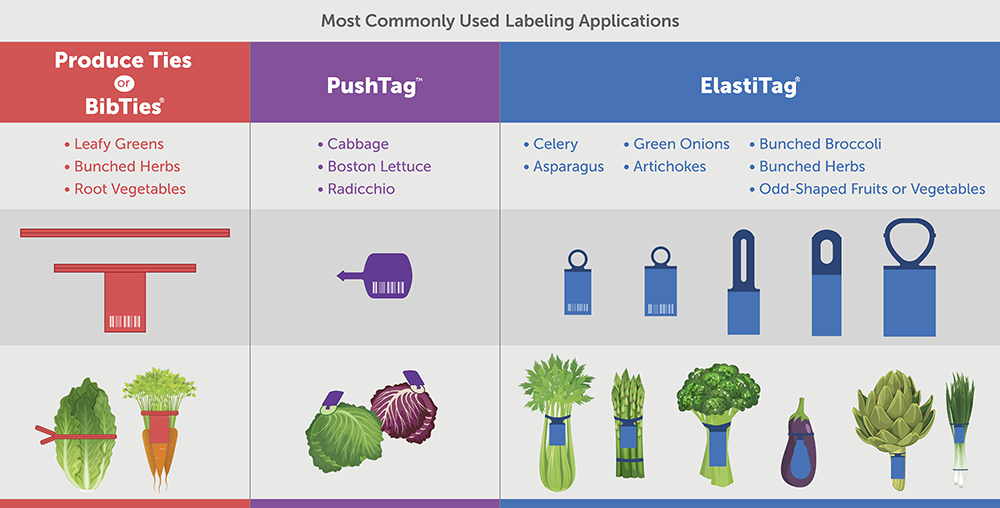Produce Packaging Label Requirements: The Basics

Packaging is a critical component to getting fresh produce into the hands of the consumer.
Produce packaging not only influences consumer purchasing decisions, it is also a requirement for consumer safety measures.
As a fresh produce grower, you need to choose packaging that 1) provides the functionality of bundling or bunching 2) meets governmental and retail requirements and 3) helps your brand foster a relationship with the consumer.
It can seem overwhelming, which is why we’ve created a guide to help you get started!
Produce Identification
It’s a requirement that you properly identify your produce on its label. There are multiple aspects to identification, including commodity type, country of origin, and company-specific code.
Commodity Type: The commodity is fairly self-explanatory – is that an orange or a grapefruit? Thanks to the label, consumers will have a clear answer within seconds.
COOL: The United States Department of Agriculture (USDA) requires that grocery stores, supermarkets, and club warehouse stores inform customers where certain foods originated, including fresh fruits and vegetables. The USDA defines acceptable methods of carrying Country of Origin (COOL) information on twist ties, tags, bands, labels, stickers, or placards.
Barcode: It is also important to have some type of coding method that allows retailers to trace your produce items back to your farm.
In the U.S. and Canada, this is most commonly accomplished with a Universal Product Code (UPC). The UPC is encoded with a 12-digit GTIN and begins with your unique company-specific prefix, assigned by GS1 to create your custom barcode label.
If your produce doesn’t have enough labeling real estate for a UPC, growers may also satisfy labeling requirements with a Price Look Up (PLU) code or DataBar. Both options are most often used for loose or bulk produce. PLU codes are assigned by IFPS Global.
International Fresh Produce Association has a lot of details about barcodes.
All of these steps help retailers trace produce back to the farm it originated.
This protects consumers if a recall needed to be issued. Since the change from generic to company-specific UPCs, your farm also receives some protection in the event of a recall.
Prior to the change, your farm was at risk of being swept up into a food safety recall if you produced the commodity at issue. Now, traceability technology is advancing to the point that retailers will be able to trace the commodity directly to the farm it originated.
A note on food safety
Now is a good time to make the case for properly vetting produce packaging manufacturers and their processes. Because the packaging comes into direct contact with your fresh produce, you want to find a produce packaging manufacturer that maintains a food safety certification. Such a certification shows they are accountable to producing a product with elevated safety and cleanliness measures.
Some common certifications recognized by the Global Food Standards Initiative include: BRC Global Standard, SQF, FSSC 2000, and International Featured Standards.
Organic: Organic is booming. In 2020, organic food sales surpassed $56 billion, up 12.8% — the highest rates recorded in organic in well over a decade. Clearly identifying that your produce is certified organic on its packaging will appeal to consumers and will help your retail partners correctly identify it as such at checkout.
According to IFPA, if you have organic produce, that should be noted above the product name on your produce tag/label/sticker. Adding the USDA certified organic logo to your label on qualifying produce will be an instant form of recognition for consumers who value organically-grown fruits and vegetables.
Visit the USDA website to learn more about organic certification and labeling.
Branding
Not only is packaging critical to meeting your legal requirements, it’s also imperative to growing your brand.
Unlike in-store displays or your traditional or digital marketing efforts, packaging is the only thing your customers are guaranteed to interact with from the moment they see it in the store to when they consume the product it packages.
Adding your company logo can enhance brand recognition and loyalty. Other popular information brands are adding to their packaging include:
- Recipes
- Preparation instructions
- Use suggestions
- Storage advice
- Health benefits
At this point, it’s natural to wonder how – on a product as small as produce ties and tags – there is any space remaining after including all the produce identification requirements. You’d be surprised what the right packaging option can accomplish beyond the bare minimum requirements. But, it takes a manufacturer that understands the fine details regarding barcode size and magnification and ability to design to maximize the space to make it all work.
With advanced planning and partnership with a quality produce packaging manufacturer, you can create custom produce packaging that not only meets requirements, but grows your brand.
Meet requirements & grow your brand with Bedford
Experienced in the produce industry, Bedford offers produce ties and tags for growers to meet their fresh produce label requirements and branding needs.

